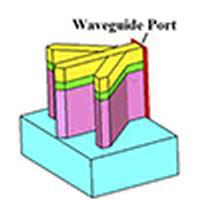当前位置:
X-MOL 学术
›
Opt. Express
›
论文详情
Our official English website, www.x-mol.net, welcomes your feedback! (Note: you will need to create a separate account there.)
Analytic approach to study a hybrid plasmonic waveguide-fed and numerically design a nano-antenna based on the new director.
Optics Express ( IF 3.8 ) Pub Date : 2020-02-03 , DOI: 10.1364/oe.373221 Maryam Khodadadi , Najmeh Nozhat , Seyyed Mohammad Mehdi Moshiri
Optics Express ( IF 3.8 ) Pub Date : 2020-02-03 , DOI: 10.1364/oe.373221 Maryam Khodadadi , Najmeh Nozhat , Seyyed Mohammad Mehdi Moshiri

|
In this paper, a wideband InP-based hybrid plasmonic nano-antenna (HPNA) operating at telecommunication wavelengths has been proposed. Monolithically integrating InP-based lasers with hybrid plasmonic waveguide (HPW) as a feed line of the proposed HPNA on the same InGaAsP/InP wafer can increase the antenna efficiency. A new vertical director has been employed to have a highly directive horizontal radiation pattern. This enhancement is attributed to the efficient coupling between the radiation patterns of arm elements as well as reduced side lobes and back-lobes levels due to the achieved impedance matching. As a result, the directivity has been increased considerably, 3.6 dBi at 193.5 THz (1550 nm) and 1.1 dBi at 229 THz (1310 nm). The HPNA shows the high directivity, total efficiency and quality factor of 11.8, 97.49% and 94.57, respectively. Further, to verify the validity of confining the fundamental TM mode to a thin layer with the lower refractive index, both theoretical and numerical methods have been employed. Therefore, we have derived an analytical formula to investigate the HPW dispersion relation based on the transfer matrix theory and genetic algorithm. Moreover, due to the HPNA ability to receive an optical signal from free space and transmit it to the waveguide based on the reciprocity theorem, the HPNA performance as an optical wireless on-chip nano-link has been investigated analytically and numerically. Additionally, to obtain a high optical power signal and steering the beam angle, the antenna gain and directivity have been calculated with two different types of array structure by controlling the relative phase shift between the array elements and elements number. To validate the array design performance, a three dimensional full-wave numerical simulation and array factor theory have been exploited. The HPNA fabrication is compatible with generic foundry technology.
中文翻译:

研究混合等离子体激元馈电的分析方法,并基于新导向器对纳米天线进行数值设计。
在本文中,已经提出了在电信波长下工作的基于宽带InP的混合等离子体纳米天线(HPNA)。在同一InGaAsP / InP晶片上,将基于InP的激光器与混合等离子体激元波导(HPW)作为拟议HPNA的馈线进行单片集成可以提高天线效率。已经采用了一种新的垂直导向器,使其具有高度定向的水平辐射方向图。这种增强归因于臂元件辐射图之间的有效耦合,以及由于实现了阻抗匹配而降低了旁瓣和后瓣水平。结果,方向性大大提高,在193.5 THz(1550 nm)时为3.6 dBi,在229 THz(1310 nm)时为1.1 dBi。HPNA的高方向性,总效率和品质因数分别为11.8、97.49%和94.57。此外,为了验证将基本TM模式限制为具有较低折射率的薄层的有效性,已经采用了理论方法和数值方法。因此,我们基于传递矩阵理论和遗传算法,推导了解析公式来研究HPW的色散关系。此外,由于HPNA具有基于互易性定理从自由空间接收光信号并将其传输到波导的能力,因此已对HPNA作为光学无线片上纳米链路的性能进行了分析和数值研究。另外,为了获得高光功率信号并控制波束角,已经通过控制阵列元件和元件数量之间的相对相移,使用两种不同类型的阵列结构来计算天线增益和方向性。为了验证阵列设计性能,已经开发了三维全波数值模拟和阵列因子理论。HPNA制造与通用铸造技术兼容。
更新日期:2020-02-03
中文翻译:

研究混合等离子体激元馈电的分析方法,并基于新导向器对纳米天线进行数值设计。
在本文中,已经提出了在电信波长下工作的基于宽带InP的混合等离子体纳米天线(HPNA)。在同一InGaAsP / InP晶片上,将基于InP的激光器与混合等离子体激元波导(HPW)作为拟议HPNA的馈线进行单片集成可以提高天线效率。已经采用了一种新的垂直导向器,使其具有高度定向的水平辐射方向图。这种增强归因于臂元件辐射图之间的有效耦合,以及由于实现了阻抗匹配而降低了旁瓣和后瓣水平。结果,方向性大大提高,在193.5 THz(1550 nm)时为3.6 dBi,在229 THz(1310 nm)时为1.1 dBi。HPNA的高方向性,总效率和品质因数分别为11.8、97.49%和94.57。此外,为了验证将基本TM模式限制为具有较低折射率的薄层的有效性,已经采用了理论方法和数值方法。因此,我们基于传递矩阵理论和遗传算法,推导了解析公式来研究HPW的色散关系。此外,由于HPNA具有基于互易性定理从自由空间接收光信号并将其传输到波导的能力,因此已对HPNA作为光学无线片上纳米链路的性能进行了分析和数值研究。另外,为了获得高光功率信号并控制波束角,已经通过控制阵列元件和元件数量之间的相对相移,使用两种不同类型的阵列结构来计算天线增益和方向性。为了验证阵列设计性能,已经开发了三维全波数值模拟和阵列因子理论。HPNA制造与通用铸造技术兼容。


























 京公网安备 11010802027423号
京公网安备 11010802027423号